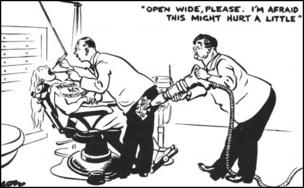|
Either,print the sources and questions and complete offline, or click on spinning graphic (left) to complete online. DTC Students may e-mail me their answers for feedback (sources courtesy of John Simkin at www.spartacus.schoolnet.co.uk ) 1) The Daily Sketch (February, 1948)
The State medical service is part of the Socialist plot to convert Great Britain into a National Socialist economy. The doctors' stand is the first effective revolt of the professional classes against Socialist tyranny. There is nothing that Bevan or any other Socialist can do about it in the shape of Hitlerian coercion.
(2) Aneurin Bevan, speech in the House of Commons (9th February, 1948)
We have provided paid bed blocks to specialists, where they are able to charge private fees (Labour MPs shout "shame"). I agree at once that these are very serious things, and that, unless properly controlled, we can have a two-tier system in which it will be thought that members to the general public will be having worse treatment than those who are able to pay.
(3) Michael Foot, the editor of Tribune, was one of those who criticised Aneurin Bevan for his decision to allow specialists to have paid beds in National Health Service hospitals.
The idea that specialists should have pay-beds was a concession. It was a direct departure from principle introduced only for the purpose of encouraging specialists to come into the Service and preventing them from setting up their private nursing homes.
So the great day came - 5th July 1948. On the day itself three-quarters of the population had signed up with doctors under the scheme. Two months later, 39,500,000 people, or 93 per cent were enrolled in it. More than 20,000 general practitioners, about 90 per cent, participated from the scheme's inception.
(4) In her book My Life With Nye, Jennie Lee describes how one woman responded to the introduction of the National Health Service.
There was a strict rule in Nye's Ministry that any unsolicited gifts sent to him should be promptly returned. On one occasion, and only one, an exception was made. Nye brought home a letter containing a white silk handkerchief with crochet round the edge. The hanky was for me. The letter was from an elderly Lancashire lady, unmarried, who had worked in the cotton mills from the age of twelve. She was overwhelmed with gratitude for the dentures and reading glasses she had received free of charge. The last sentence in her letter read, "Dear God, reform thy world beginning with me," but the words that hurt most were, "Now I can go into any company." The life-long struggle against poverty which these words revealed is what made all the striving worthwhile.

![[Page visit counter]](http://counters.direct.zyweb.com/counter/username/aliandy_10/key/NNVW/) |


